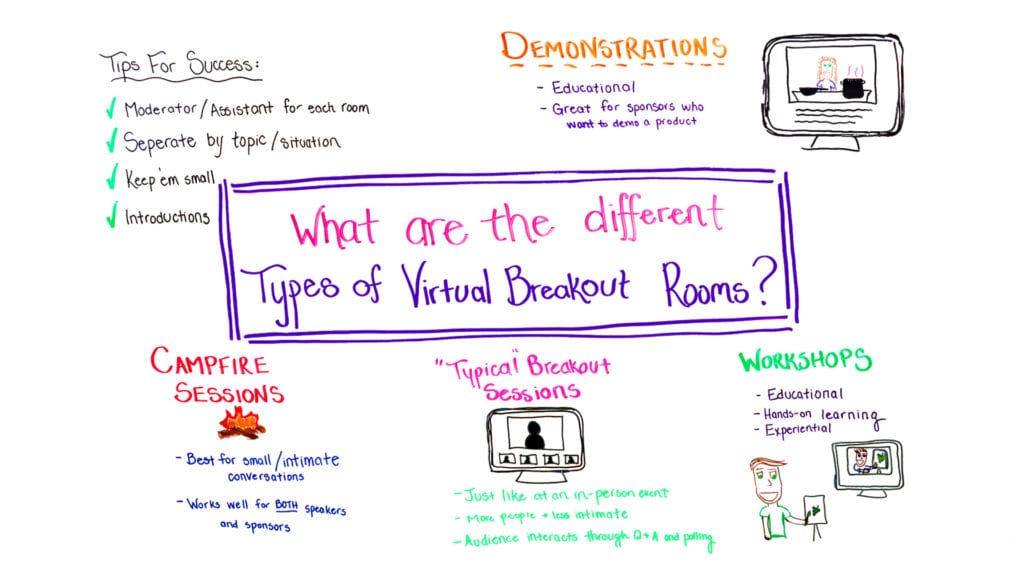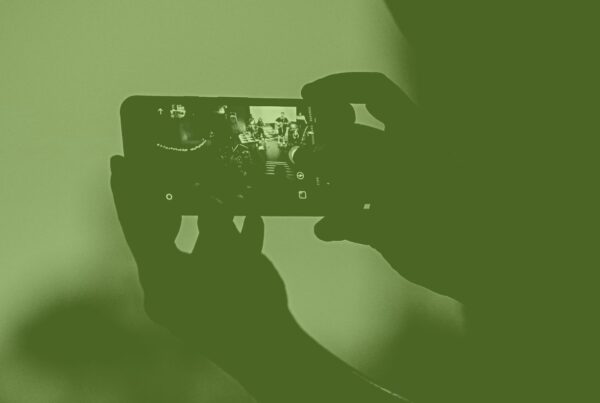Let’s talk about virtual breakout rooms! Now that virtual and hybrid events are part of the new normal, planners must learn how to make the most of it. Engaging the audience, activating sponsorships, creating exciting happy hours…all of this now requires extra pivoting. And so do your virtual breakout rooms.
So on this week’s episode of Whiteboard Wednesday, Will Curran is ready to drop some wisdom. Because this topic has more to it than meets the eye. When it comes to virtual breakout rooms, there are several types you can adopt. And each of them offers the audience a specific set of advantages. So strap on tight and join us for another exciting episode of Whiteboard Wednesday!
Virtual Breakout Room Sessions
So let’s start with the obvious one, which is the typical breakout room session. Everybody always wants to think about the in-person typical events when you go to a breakout session. You have a speaker, and they’re speaking to a group of people, and presenting some information. That’s pretty typical. Well, it’s really easy. The important thing to know though is that when you add more people it’s going to become less intimate, so you get that exchange when it comes to it.
If there are a lot of questions coming in, the presenter might not be able to get to them. With these virtual breakout rooms, people are going to be interacting primarily through the Q&A, and the chat, and polling versus other interactions.
Campfire Sessions
Well, if you’re interested in hearing more about people talking to each other that’s where we go into the campfire sessions when it comes to virtual breakout rooms. So these are smaller, intimate conversations between people exchanging ideas, sharing experiences, whatever it might be. And sometimes you can have multiple campfire sessions almost inside of a larger campfire session as well, and these are really best for those small, intimate conversations.
These work great for both the speakers to be able to share their information and get really hands-on. Not so hands-on, but really in-depth with the attendees. And these are also great for sponsors. Imagine a sponsor being able to have a captive small audience to talk about either their product or their experience. They’re really, really great for your breakout rooms.
Workshops
Let’s talk about education and workshops. This is your hands-on learning educational experience. It’s very experiential. Imagine learning how to paint, or learning how to build something – whatever it may be. Very hands-on, and allows people to really learn by doing.
So the typical breakout sessions, that’s for your auditory and visual learners. This is for your people who learn by doing. And this might be more for people learning by talking and exploring ideas together. And this is really great for virtual. Imagine, for example, shipping out a bunch of art supplies to everybody and then saying, “Hey. We’re going to teach you how to do oil painting,” and then they literally get to do it as they learn it. Wouldn’t that be super cool?
Virtual Breakout Rooms: Demos
We’re moving on to demonstrations, the demos. Everybody wants to do it, especially if you’re in the SAS, or software world. And you want to be able to show your software off, show how it works, or how to work through things. These are very educational as well. And they are great for sponsors who want to show off a product as well.
So for example, let’s say you’re a marketing software company, and you’re trying to show how they can use your marketing software to generate five times more leads in the next quarter. This would be incredible to show off, especially for existing customers too. Because then the existing customers can learn tactical ways to expand their knowledge by utilizing your software.
Tips For Success!
Let’s talk about some tips for success when it comes to virtual breakout rooms versus an in-person experience. First thing, you need to make sure that you have a moderator or an assistant for each room. That might seem excessive. But why do we want to make sure that we had one person in every room? Why is that important?
Engagement
They do a couple of things. The first thing they do is help moderate the Q&A. If there are some weird questions coming in, and you don’t want to distract the speaker, they can manage that. If you’ve got a troublemaker or a bad apple in the group, they can take care of that. That’s kind of the obvious thing, but what most people don’t think about is that this moderator’s job is to help facilitate that engagement.
If you have a presenter who’s not very familiar with your platform and how it all works that can be really bad. So make sure they know about your platform. Also, imagine having a moderator post questions in the chat as the person’s speaking, commenting back, and quoting the presenter as they talk. It’s really a good job for this person, who’s the moderator assistant in each room, to be really engaged. It can make or break these virtual breakout rooms.
Don’t Put All Your Eggs In One Basket
The next thing is, separate them by topic and situations. Talk about those filters that we have over on our agenda. Pick out different tracks for each one to be in, and make sure they’re separated. So then, that way, you don’t want to put all your campfire sessions, and say, “Hey, let’s talk about sales and marketing,” in one campfire session. It probably should be better that we have a campfire session for sales, a campfire session for marketing, and so on.
Keep It Small
You’ve got to keep them small. Before, we couldn’t do a lot of small breakout rooms. Because if you wanted to have 400 four-person breakout rooms in a conference you’d have to have 400 rooms to do that. Well, spinning up each of these rooms can be pretty easy, other than needing a moderator/assistant in each room. But keeping them small allows people to really interact with each other, and keep it intimate, and create the experience that you weren’t getting before. Especially when it comes to these typical breakout rooms.
Introductions Matter!
Always do introductions as well. Give a chance for people to be able to say who they are, and say where they are, especially if you are doing a typical breakout room. A campfire session makes sense. Everyone’s going to be talking and introducing each other. And then, obviously in these education session speakers then present and introduce themselves.
But when it comes to the events one of the best things you can do is posing an interesting weird question that everybody feels really easy to answer at the beginning. So away from the, “Hey, who are you, and where are you tuning in from?” Stop doing that. That’s the most boring thing you could do. Instead, say something like, “Hey, what’s the last Netflix show that you binged that you’re embarrassed to admit,” or “Hey, what’d you have for breakfast this morning?” Doing something a little bit more unique gets people engaged.
Conclusions
And that’s a wrap on his week’s edition of Whiteboard Wednesday on virtual breakout rooms! So, are you ready to take the leap and create your very own version of these?
Download our free virtual event planning checklist today and learn what you have to do every step of the way to create an unforgettable experience for your attendees. And if you’re looking for the best virtual event production company out there, chat with us! The Endless team is here to help.
Make sure you join us again next week for another episode. In case you’re interested in extra virtual event content, click here to learn more while you wait for another Whiteboard Wednesday!











